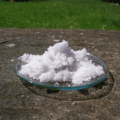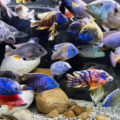Live life in colors! Learn the best care tips and more for the ravishing Redbreasted Acara (Laetacara dorsigera) in this guide!

Ready to dig into the best Laetacara dorsigera care guide of all time? I’ve been waiting for you!
The Laetacara dorsigera, commonly known as Redbreasted Acara, is a freshwater jewel cichlid and a small, colorful species native to the tranquil streams of South America and admired for its commanding red and orange tones on its chest alongside its calm temperament. The Redbreasted Acara is a beautiful addition to any community tank thanks to its ease of care for both beginner and expert aquarist.
This Redbreasted Acara overview will bring you closer to your dream of successfully housing these gems, continue reading to find out more!
Striking Appearance of Laetacara dorsigera

Hobbyists love this vibrant aquarium cichlid due to its stunning appearance; I will explain more it in this section.
The Redbreasted Acara’s color pattern is distinctive, comprising a red-hued chest and iridescent body that reflects varying shades of blue, green, and gold – making it the perfect centerpiece in any tank.
You have never seen shimmer on a cichlid like this before, and when it comes in contact with just the right amount of light, the Laetacara dorsigera appearance holds you in a trance.
Unique Traits: The compact size of this species, usually around 3-4 inches, and graceful movement as it glides peacefully through the water with its famed Redbreasted Acara colors provide a visually stimulating experience.
Creating the Ideal Tank for Laetacara dorsigera

Setting up a suitable aquarium for Redbreasted Acara involves infusing specific characteristics specific to its primary home to make it comfortable. How do you do this? I’ll help you out.
Tank Size and Dimensions
Get familiar with how to get the perfect Laetacara dorsigera tank setup below.
| Tank Size | Minimum of 30 gallons for a small group of Redbreasted Acara. |
| pH Level | 6.0-7.5 |
| Water Softness | 4-12 dGH. Soft to moderately hard water is the perfect option for this Cichlid. |
| Water Temperature | 75-820F |
Substrate and Decor
The general idea behind adding substrate and decor in a Redbreasted Acara tank is to replicate this freshwater cichlid’s natural habitat so you get the best from them.
- Add fine gravel or sand, preferably a dark shaded, to promote contrast so the shimmering color of your Laetacara dorsigera can really come through. The smooth gravel also imitates the feeling of freshwater riverbeds.
- For decor, driftwood and rocks are great hiding spots during breeding season.
- Live plants, including Anubias, Amazon Swords, Moss, and Java Fern, are great for mimicking the fish’s natural environment and enhancing the tank’s whole aesthetics.
- Add dim lighting to compliment their slow-moving habitat and highlight their radiant hues.
That’s all you need to create the best indoor tank for your Laetacara dorsigera. Now, how do you feed them? You’re a blink away from finding the answer.
Feeding Laetacara dorsigera: Nutritional Needs for Vibrant Health

A healthy cichlid’s nutrition revolves around a balanced, protein-focused diet supplemented with plant matter in response to their omnivorous feeding pattern. Focusing on a variety-based diet is vital to help these cichlids maintain their vibrant coloration and health.
Diet Suggestion: Your ideal Redbreasted Acara diet must comprise live or frozen foods (bloodworms, brine shrimps, and daphnia) rich in natural supplements, high-quality flakes or pellets that are rich in essential vitamins and minerals, and plant-based supplements from blanched vegetables to aid easy digestion and provide intense coloration (blanched carrot is an excellent source of vitamin C and carotene for brighter looking hues).
Feeding Tips
- Portion control is a great aspect of feeding Laetacara dorsigera, and you must treat it seriously to protect your cichlids’ health. Do not supply your fish with what they can’t consume within 2-5 minutes.
- Feed them small meals 2-3 times daily to allow them to exhibit their natural feeding behavior.
- Promptly remove leftovers to reduce the chances of water disease outbreaks and sick pets.
For more on feeding your aquatic pets check out The Ultimate Guide to Fish Food: Pros and Cons & Best Choices!
Breeding Laetacara dorsigera: Encouraging Spawning in Captivity

Interestingly, Laetacara dorsigera are quite monogamous when picking their mates, and they exhibit great parental care for their young ones, given the right environment and water conditions.
Breeding Laetacara dorsigera begins with a monogamous pair forming a bind and cleaning their spawning spot in unison, after which the female lays about 50-150 eggs and lets the male perform the act of fertilization.
Breeding Conditions
- Keeping slightly elevated temperatures and maintaining soft, acidic water conditions helps aid the natural spawning process.
- Provide a separate tank for the breeding and fry care process to reduce stress from other fish.
- Ensure there are enough hiding spots and smooth surfaces for the cichlids to lay eggs on.
Cichlid fry care tips
- Install a sponge filter in the breeding tank to protect the fry from being affected by strong currents or being sucked into the filtration system.
- Begin feeding cichlids fry with liquid fry food after birth and transition to finely crushed flakes/brine shrimp as they develop.
- Juvenile Laetacara dorsigera require more nutrients, so keep the feeding frequency between 3-4 times daily, in small portions.
- Regular water changes are great for fry health and development. A 30-50% weekly water change is just perfect.
The information here is enough to kickstart your journey toward Redbreasted Acara reproduction. You’re welcome!
Compatible Tank Mates for Laetacara dorsigera

Interested in finding suitable Redbreasted Acara companions? Here’s what I’ve got for you!
Laetacara dorsigera are easygoing freshwater species that don’t do well around aggression or hyperactivity, so you must pair them with only peaceful community fish.
- Compatible tank mates for Laetacara dorsigera include Tetras, Rasboras, Corydoras, and other small cichlids with similar water parameter requirements and feeding patterns.
- On the flip side, large cichlids, Green Terrors, Pictus Catfish, and Large Gouramis can harm or stress out your pets due to their size, water parameter needs, and highly active routine.
Preventing Common Health Issues in Laetacara dorsigera
Redbreasted Acara is prone to various health problems, including stress, fin rot, and parasitic infections. This doesn’t mean you’re doing badly as a hobbyist; it just means you need more guidelines on providing the best Laetacara dorsigera health care.
Preventing cichlid illnesses: Maintaining stable water parameters and a clean environment void of food remnants and fish waste is a great step towards freshwater fish disease prevention.
Signs of illnesses: Watch out for key indications of illnesses such as loss of appetite, discoloration, and abnormal swimming.
Extending the Lifespan of Laetacara dorsigera

Exposing your Laetacara dorsigera to stress, a mediocre diet, and an unclean tank is a recipe for disaster and would do the exact opposite of extending freshwater fish’s lifespan.
As a hobbyist, you need practical tips for long-term cichlid care, including providing a balanced protein-based diet, ensuring the water condition stays pristine, and enabling a peaceful environment with the right companions.
Laetacara dorsigera extended lifespan tips:
- Routine maintenance is a great way to keep your cichlids around for longer.
- Carrying out thorough health checks and quarantining new additions helps to curb disease spread and death.
Conclusion: Redbreasted Acara at a Glance
It’s your responsibility to ensure the coloration of your redbreasted acara health stays intact through proper freshwater cichlids care. After all, they’re some of the best guests you can house in your tank due to their peaceful temperaments and adaptability to extreme water conditions.
For aquarists reading this, creating an optimal environment for your stunning cichlid is as urgent as your burning desire to start keeping them, so keep our Laetacara dorsigera guide close.
Let’s review some helpful Redbreasted Acara tips we’ve learned before calling it a day!
- Quick detection of disease symptoms is always to your best advantage.
- Pay attention to feeding them a healthy diet; it’s a garbage-in, garbage-out situation.
- Mimicking their natural habitat in tanks is great for their lifespan.











1 thought on “Redbreasted Acara (Laetacara dorsigera): Care, Setup, and Breeding Guide”